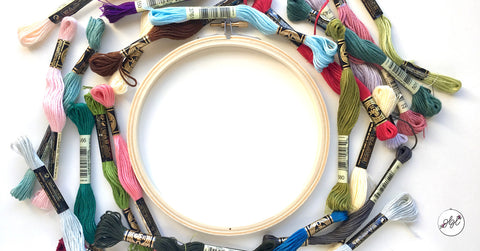When learning embroidery, there are a ton of great resources out there, but it can all be difficult to sift through! Trust me - I've read most of it and have experienced plenty of trial and error along the way.
To help you get started, here are 10 embroidery dos and don'ts that all beginners should know.
1. Don't Be Afraid to Start
Anyone can learn to embroider! With only a few simple supplies and a little bit of time, you can easily stitch beautiful works of art from the comfort of your own home.
You'll be surprised how relaxing and therapeutic the process is - it's the perfect way to unwind and create something meaningful. Start with a beginner embroidery kit and you'll be stitching in no time!

2. Do Use an Embroidery Hoop
Embroidery hoops keep your fabric tight to ease the stitching process and prevent your project from puckering.
When working with an embroidery hoop, always tighten the hardware at the top and pull along the edges of your fabric until it's as tight as a drum. Plus, once you're done, you can use it to frame your embroidery art.
3. Don't Use the Wrong Needle
Embroidery needles are sharp and slender, helping your embroidery floss pass through your fabric with ease. Embroidery needles range in sizes, and I recommend sizes 1-5 for beginners.
Using a needle that's too large or too blunt can leave holes in your fabric and make stitching more difficult. It's a common embroidery mistake to avoid.
4. Do Pull Thread from the Bottom
Always pull your DMC embroidery floss from the bottom of the skein, next to the numbers to prevent knotting.
For best results, work with a piece of embroidery floss that's about a shoulders-width-apart in length.
5. Don't Use Stretchy Fabric
When it comes to hand embroidery, using a lightweight cotton or linen fabric will help ensure your needle easily glides through the fabric.
Avoid stitching on stretchy or thick fabric when possible. Your hands will thank you!
6. Do Use an Erasable Pen
When transferring a pattern, never leave permanent marks on your fabric. Both water-soluble and heat-erasable pens work amazing on fabric and will disappear once your embroidery project is complete.

7. Don't Track Floss Across Your Work
As a best practice, use a pair of small crafting scissors to keep the back of your embroidery project as clean as possible while stitching.
Never track floss across the back from one area of your project to another. This can show through the front side of your embroidery art and diminish the appearance of your finished project.

8. Do Curate Your Workspace
Always embroider in a well-lit space to protect your eyes. Practice good posture, grab these cozy essentials, and take frequent stretch breaks to relax your hands, shoulders, neck, and back.
Stitching for too long in a poorly-lit space or awkward position isn't so fun afterwards. Take care of yourself!

9. Don't Copy Other Artists
Especially if you're just starting out, support a small business by purchasing an embroidery pattern or DIY kit from them.
My digital patterns are under $10, making them a cost-effective way to stitch that new design you've been eyeing.

10. Do Experiment with New Embroidery Stitches
There's so much to learn when it comes to embroidery and experimenting is where the magic happens!
Don't be afraid to try different stitches, unique color combinations, or fun supplies. You'll learn something new and expand your embroidery skills each time.

Want to Learn More?
Check out The Best Embroidery Advice I've Ever Heard or The Essential Embroidery Supplies for Beginners.
Thank you for reading these embroidery dos and don'ts! I participate in affiliate programs and may earn a share of revenue from your purchase.






